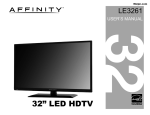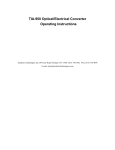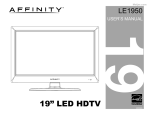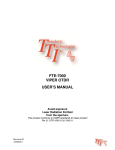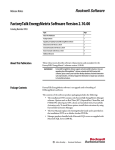Download LTS-1500 Fiber Optic Test Set Operating Instructions
Transcript
LTS-1500 Fiber Optic Test Set Operating Instructions Terahertz Technologies Inc. 169 Clear Road, Oriskany, NY 13424 TEL: (315) 736-3642 FAX (315) 736-4078 E-mail [email protected] Contents Introduction...............................................................................................................................1 Specifications...............................................................................................................................2 Unpacking and Inspection...........................................................................................................4 Power Considerations..................................................................................................................4 Instrument Operation............................................................................................................5 Operating Considerations............................................................................................................8 Service/Warranty Information.............................................................................................13 Introduction The LTS-1500 Fiber Test Set is a convenient hand held instrument that incorporates a sensitive optical power meter containing an InGaAs detector for maximum sensitivity and stabilty, three stabilized laser light sources and the means to make automatic loss measurements at all three wavelengths over a pair of singlemode fibers simultaneously. The unit also functions as a fiber identifier that permits modulation and detection of the laser sources at three frequencies, 270 Hz, 1000 Hz, 2000 Hz. Each instrument is equipped with adaptors to acommodate FC, ST or SC connectors for both the laser ouput and the power meter input. The LTS-1500 is powered by a high capacity lithium polymer rechargeable battery and/or a universal wall mount supply that operates from 95-260 VAC, 50-60 Hz. It is equipped with mains plugs for North America, continental Europe, Great Britain and Australia. Battery life exceeds 15 hours at full charge. Up to 2000 triple wavelength loss measurements may be stored for later download to a host computer via a USB port. Application software is also provided for Windows-based computers. A rugged hard plastic storage/carrying case and a protective rubber boot make this instrument an excellent choice for outside plant use. Page 1 Specifications Power Meter Detector Type Calibrated Wavelengths Units of Measurement Display Update Rate Power Input Range Power Measurement Uncertainty Laser Output Power Output Stability Laser Wavelengths Provided Modulation Modes Provided Autotest Measurement Rate Laser Safety Classification. Autotest Range Display Indium-Gallium-Arsenide 850, 1300, 1310, 1490, 1550, 1625 nm dBm, dB, 0.01 db resolution Six times per second +5 dBm to - 77 dBm ± 0.18 dB under reference conditions, ± 0.25 dB from 0 to -65 dBm, ± 0.35 dB from 0 to +5 dBm and from -65 to -77 dBm 0 dBm, 1 mw ± .05 dB / 24 hrs @ constant temp,, ± .02 dB/C temperature coefficient 1310 nm ± 20 nm, 1490 ± 20 nm, 1550 ± 20 nm CW, 270 Hz, 1000 Hz, 2000 Hz Four seconds per wavelength Class I safety per FDA/CDRH and IEC-825-1 regulations 0 to - 36 dB LCD, power reading, 0.4” high digits, .01 dB resolution Power meter, laser wavelength display 0.16” high digits Page 2 Specifications (Continued) Annunciators Storage Locations Battery Supplied Operating Time Power Supply / Charger Provided Power Requirements Operating Temperature Range Dimensions (mm) Weight Accessories Provided Standard Warranty Fiber ID, - 3, modulation mode - 4, Autotest - 2, Lo Bat, Auto Off 2000 Rechargeable Li Polymer Approximately fifteen hours following a full charge Wall Mount, Universal, US, UK. Continental Europe, and Australian Plugs Included 95-260 VAC, 50-60 Hz, 3 VA Max -10 to 45 C 150 L x 100 W x 35 H ( with rubber boot ) 0.52 Kg FC, ST, SC adaptors for both source and power meter, rubber boot, Battery, Power supply/charger, manual, USB Cable, PC application software Two years, Components and Workmanship, 30 Day Satisfaction Guarantee Page 3 Unpacking and Inspection Prior to shipment this instrument was inspected and found to be free of mechanical and electrical defects. Upon acceptance by the carrier he assumes responsibility for its safe arrival. After unpacking, examine the unit for any evidence of shipping damage. Should you receive this instrument in a damaged condition, apparent or concealed, it must be noted on the freight bill or express receipt and signed by the carrier’s agent. Failure to do so could result in the carrier refusing to honor the claim. Upon filing a claim TTI should be notified. Power Considerations The LTS-1500 is equippped with a 9 V lithium polymer rechargeable battery. It will power the unit for approximately 15 hours following a full charge. For bench top operation, a wall mount power supply/ charger is provided. This supply may be operated from 95 - 260 VAC , 50-60 Hz. Four interchangeable mains plugs are supplied. (North America, continental Europe, and Australia) If the supplied battery is discharged in the field and no mains power is available, a 9 V alkaline or other primary battery may be used temporarily. NEVER attempt to use the charger with any battery other than the one supplied with the unit or severe damage to the instrument may result! Page 4 Instrument Operation 0RGHO/76 2SWLFDO)LEHU7HVWHU The LTS-1500 consists of an optical power meter and three stabilized laser light sources. Refer to Fig. 1 for location and appearance of the controls and annunciators to be described. Power, ON/OFF- This control alternately energizes and de-energizes the unit. Holding the key down for at least four seconds at turn-on will invoke the Auto-Shutdown mode which turns the unit off following fifteen minutes without a key press. This mode conserves the battery if the user should forget to turn the unit off. Sto Loss λ Store Ref dB dBm Rcl Loss Source Mod Clear All Power Meter Wavelength Selector- This control selects the calibration factor for the wavelength being measured by the power meter. The progression is as follows: 850 nm => 1300 nm => 1310 nm =>1490 nm => 1550 nm => 1625 nm => 850 nm, etc. The wavelength is displayed in the upper right hand corner of the display. £ ǯ Fig. 1 Page 5 Page 5 Instrument Operation (Continued) 0RGHO/76 2SWLFDO)LEHU7HVWHU Store Reference Level- This control saves the currently measured power level for the wavelength in use. When in the dB mode, all subsequent readings will be made relative to this power level. A storage location is maintained for each of the six calibrated wavelengths. dBm, dB mode Selector- This control alternately switches between comparing the currently Sto Loss λ Store Ref dB dBm Rcl Loss Source Mod Clear All measured power to 1.00 milliwatts (dBm mode) or to the stored reference power level. (dB mode) When changing to the dB mode, if no reference level has been previously stored, an error tone will sound and the message “reF ?” will be displayed for a few seconds. The reference values are volatile, that is, they are not saved when the unit is powered down. If you are in dB mode and attempt to select a wavelength that has no stored reference the error message will appear and the wavelength change will not be accepted until a reference level has been stored for the new wavelength. Return to the dBm mode and store a reference level for the new wavelength. £ ǯ Fig. 1 Page 6 Instrument Operation (Continued) 0RGHO/76 2SWLFDO)LEHU7HVWHU Recall Loss - When pressed, the unit enters Recall Mode which displays a memory location Sto Loss λ Store Ref dB dBm Rcl Loss Source Mod and the value(s) stored in it. If the memory location is empty, four horizontal lines will appear in the main display as well as the power meter wavelength display. In this mode the user may access any memory location by using the up and down controls (Source and Mod) Holding one of these buttons down will cause it to accelerate through the memory locations so that all 2000 locations can be accessed quickly. When a location contains an AutoTest measurement all three loss measurements will be shown in a repeating sequence. An Auto Test measurement will be indicated by the presence of the Auto Test annunciator on the display without the up or down arrows. To exit the Recall mode simply press Rcl Loss again. Clear All £ ǯ Fig. 1 Page 6 Instrument Operation (Continued) 0RGHO/76 2SWLFDO)LEHU7HVWHU Store Loss - This control saves the current measurement value(s) to non-volatile memory for Sto Loss λ Store Ref dB dBm Rcl Loss Source Mod later downloading. This may be a dBm measurement or a three wavelength dB loss measurement. When the button is activated the memory location is flashed on temporarily. The memory locations will begin at address 000 and auto increment as each new value is stored. Locations may be skipped if so desired by invoking the Recall mode and advancing the memory pointer. The next storage location will be incremented from this point. Upon filling memory location 1999 no more data may be stored and the screen will indicate “FULL” even though some locations may have been skipped. The memory must then be cleared before new data can be stored. Be sure to download any desired data before clearing the memory. Clearing memory is accomplished by holding down the Sto Loss and Rcl Loss buttons simultaneously for four seconds. The display will indicate “CLr” while the memory is being erased. The memory address display will indicate progress of the operation. Clear All £ ǯ Fig. 1 Page 6 Instrument Operation (Continued) 0RGHO/76 2SWLFDO)LEHU7HVWHU Source Selector - This control selects the laser wavelength to be used. The lasers are initially turned off when the instrument powers up. Pressing the Source button activates the laser and changes wavelength in the following sequence: 1310 nm => 1490 nm => 1550 nm, => Auto Test (in which the lasers are activated in a sequence of 5 seconds each), => OFF. Sto Loss λ Store Ref dB dBm Rcl Loss Source Mod Clear All £ ǯ When transmitting in Auto Test, the Annunciator will appear at the top of the display with an uppointing arrow. The source wavelength display will automatically change in accordance with the laser in use. Modulation Selector- This control selects the modulation of the laser source. This feature permits using the instruments to identify a particular fiber in a cable. The sequence is as follows: Continuous Wave (CW) => 270 Hz, => 1000 Hz => 2000 Hz => CW. The modulation is a 50 % duty cycle square wave. An arrow points to the modulation mode selected. When the power meter detects light modulated at one of these frequencies the associated annunciator will flash. Fig. 1 Page 7 Operating Considerations Indicates the battery is low. Unit will shut down momentarily. AutoTest Annunciator, Up arrow indicates the unit is transmitting auto test signals, down arrow indicates unit is receiving auto test signals. When “Source” is displayed the following numbers indicate the wavelength of the source that is currently in use. (The exact measured wavelength is always displayed.) Units of Measurement, dB or dBm Arrow indicates how the laser source is to be modulated, if annunciator is flashing it is receiving modulation of that specific frequency. Wavelengths will change every few seconds during Auto Test. When “Mem” is displayed the following numbers indicate the memory location that has been recalled. Fig. 2 Power Meter Calibration Wavelength setting. Will change automatically when receiving AutoTest signals. Not active during Auto Test When this annunciator is on the unit will automatically shut down following 15 minutes without a key press Page 8 Operating Considerations Optical Power Measurements Connect the fiber carrying the optical power to be measured to the LTS-1500 detector utilizing the adaptor that mates with the fiber connector style in use. Energize the unit. Select the wavelength calibration factor that matches the wavelength of the light being measured by pressing the λ key repeatedly until the desired wavelength setting appears on the display. (Refer to Fig. 2) The power reading will now indicate the optical power in units of dBm. If the power level is greater than +5 or less than -77 dBm the display will indicate an out-of-range condition by a series of dashes across the main display. To save the power measurement press Sto Loss. The Mem: annunciator will flash on briefly and indicate the memory location to which it is being saved. (Refer to Fig. 2) To make a relative power measurement you must first save the reference power level by pressing the Store Ref button. Then press the dB/dBm button. The units of the display will now change to dB. Subsequent readings will now be displayed in terms of dB relative to the stored reference value. A reference memory location is provided for each calibrated wavelength.These stored reference values will be lost once the unit is turned off. Stored power level measurements may be recalled and displayed by pressing Rcl Loss. Page 9 Operating Considerations Optical Power Measurements (continued) The memory location will be displayed following the Mem: annunciator. Use thet , uarrows (Source, Mod respectively) to access any desired memory location. Holding these buttons down will cause the memory location to advance automatically. When the limits are reached, (0 and 1999) the memory location will roll over from 1999 to 0 and from 0 to 1999. An Auto Test loss measurement will be displayed as follows: The Auto Test annunciator will be displayed without the Up, Down arrows. The stored loss values and the wavelength at which they were measured will be displayed sequentially for a period of 5 seconds each so that they may be copied down if so desired. If simple power levels were stored they are displayed along with the wavelength at which they were measured. To exit the Mem: mode, simply press the Rcl Loss button again. The unit will now revert back to the active measurement mode. Page 10 Operating Considerations Using the Laser Source The laser source is equipped with interchangeable adaptors that accommodate connection to FC, ST, and SC style fiber optic connectors. It is located at the top left of the unit when facing the display. To change adaptors, remove the two Philips head screws that retain the adaptor, remove the old adaptor and replace it with the desired adaptor and replace the two screws. The lasers are initially in the off state when the unit is powered up. Pressing the Source button activates the laser and changes wavelength in the following sequence: 1310 nm => 1490 nm => 1550 nm, => Auto Test (in which the lasers are activated in a sequence of 5 seconds each), => OFF. When transmitting in Auto Test, the Annunciator will appear at the top of the display with an up-pointing arrow. The source wavelength display will automatically change in accordance with the laser in use. The laser wavelength display shows the actual measured wavelength of the laser in use. In the non-auto test mode the lasers may by used in the CW (continuous) mode or they may be Page 11 Operating Considerations Using the Laser Source (continued) modulated by a square wave of 270 Hz, 1000 Hz, or 2000 Hz. An arrow next to these values on the screen indicate the modulation mode in use. Note that when measuring average power of the lasers the output will drop by exactly 3.01 dB as the source is off precisely half of the time. (This is also true of the laser output when in the Auto Test mode however the unit receiving this signal automatically compensates for the loss in average power and this is transparent to the user.) The modulation function is useful for fiber identification and for general purpose optical component testing. The unit that receives one of the modulated frequencies will flash the appropriate frequency annunciator, that is, 270 Hz, 1000 Hz, or 2000 Hz.. Page 12 Warranty and Repair Information REPAIR INFORMATION Products manufactured by Terahertz Technologies Inc.(TTI) are designed and fabricated to provide reliable performance. However, in the event that service is required, both telephone technical assistance and factory repair services are available. Call (315) 736-3642 for information. For IN-WARRANTY REPAIRS, call us to obtain a Returned Material Authorization number, (RMA Number). All products are to be returned to TTI with freight charges pre-paid. Those products sent under warranty will be returned to our customers pre-paid. We cannot be responsible for returned products that do not reference the TTI RMA number. For OUT-OF-WARRANTY repairs, services are billable for both time and materials. Page 13 LIMITED WARRANTY TERAHERTZ TECHNOLOGIES INC. (“TTI”) WARRANTS THAT TO THE FIRST PURCHASER, FOR A PERIOD OF TWO YEARS FROM THE DATE OF RECEIPT, THAT THIS PRODUCT (“THE PRODUCT”) WILL BE FREE FROM DEFECTS IN MATERIALS AND MANUFACTURING. THE FOREGOING WARRANTY IS THE ONLY WARRANTY, EXPRESS OR IMPLIED, GIVEN BY TTI, I.E., THERE IS NO WARRANTY OF FITNESS FOR A PARTICULAR PURPOSE. TTI HEREBY DISCLAIMS ANY EXPRESS OR IMPLIED WARRANTY OTHER THAN THE WARRANTY IN THE FIRST SENTENCE TO THE FULLEST EXTENT PERMITTED BY LAW. THE SOLE AND EXCLUSIVE REMEDY UNDER THIS WARRANTY IS REPAIR OR REPLACEMENT AT TTI’S OPTION OF ANY PRODUCT THAT PROVES TO BE DEFECTIVE IN MATERIALS OR MANUFACTURING WITHIN TWO YEARS OF RECEIPT OF THE PRODUCT. NOTE: THIS WARRANTY DOES NOT APPLY TO ANY PRODUCT WHICH HAS BEEN SUBJECT TO MISHANDLING, MISUSE, OR SERVICE BY UNAUTHORIZED PERSONNEL OR TO ANY PRODUCT WHICH HAS BEEN DAMAGED, MODIFIED, ALTERED OR TAMPERED WITH. TO THE FULLEST EXTENT OF THE LAW, TTI DISCLAIMS ALL LIABILITY FOR ANY OTHER DIRECT, INCIDENTAL OR CONSEQUENTIAL DAMAGES ALLEGED TO BE CAUSED BY A DEFECTIVE PRODUCT, I.E., TTI WILL NOT BE RESPONSIBLE FOR ANY PERSONAL INJURY, PROPERTY DAMAGE OTHER THAN THE COST OF REPLACING THE PRODUCT OR ANY OTHER MONETARY DAMAGE SUCH AS LOST WAGES OR PROFITS CAUSED BY ANY USE, ATTEMPTED USE OR INABILITY TO USE THE PRODUCT. NOTE: BY USING THE PRODUCT, YOU AGREE THAT REPAIR OR REPLACEMENT AT TTI’S OPTION WILL FULLY SATISFY TTI’S WARRANTY OBLIGATION TO YOU, WHETHER IN CONTRACT, TORT, NEGLIGENCE, STRICT LIABILITY OR OTHER APPLICABLE LAW. Page 14


















